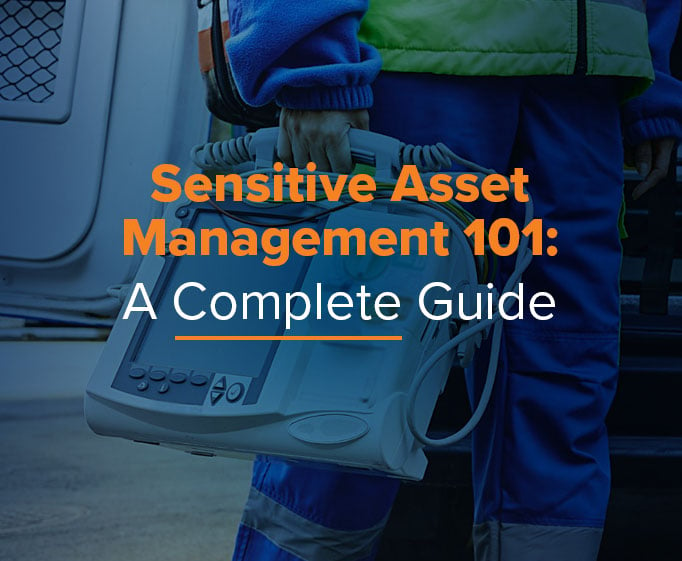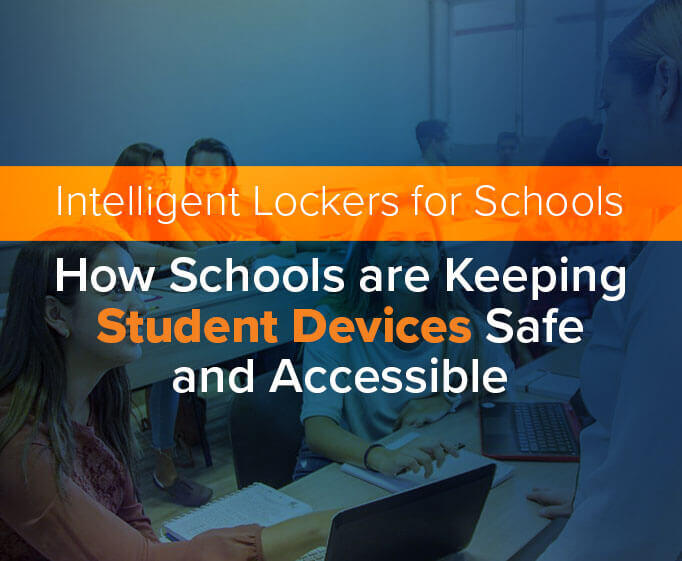By Jay Palter | April 14, 2025
I
n modern business, your productivity will plummet if your personnel don’t have the sensitive assets and smart equipment they need to do their job. And often, it’s not just the physical tool itself. Today, data matters more than anything, and handheld equipment in the field collects some of the most important on-the-ground information your business needs to operate at peak efficiency.
So, if sensitive physical assets are that important, how come so many businesses still rely on outdated pen-and-paper log books for tracking? If warehouse workers don’t have their scanner, they’re wasting a shift. If an EMT doesn’t have a charged radio, lives could be on the line.
This guide covers everything you need to know about managing sensitive physical assets and equipment. And we want to emphasize that it is management. If your equipment is truly critical or sensitive, you need more than just security. You need control, visibility, and risk mitigation. That requires a comprehensive management platform.
What Is a Sensitive Asset? Definition, Types, and Real-World Examples
In business, a “sensitive” physical asset is any tool or item that, if lost or compromised, could meaningfully disrupt operations or create significant security risks.
If a single screwdriver went missing, your organization would not be inconvenienced. Workflows won't stop, your budgets won’t be disrupted by replacing it, and meaningful work hours won’t be spent remediating the loss. A screwdriver is not sensitive.
However, if an augmented reality (AR) headset goes missing by your specialist engineer who is one of only ten people in the world certified to repair a particular piece of industrial equipment. In that case, that is a real problem. The headset itself is expensive, but more importantly, a critical piece of infrastructure is out of commission until you find or replace it. And a highly-skilled professional on a six-figure-plus salary is sitting idle on their most important task. That AR headset is definitely sensitive.
Sensitive assets can be split into four general categories:
- Specialized tools: Calibrated measurement devices in manufacturing, diagnostic equipment in healthcare, or proprietary tools used in research and development.
- Access control tokens: If a facility is sensitive, the ID cards and master keys used for access control should also be treated as sensitive.
- High-value equipment: Prototypes, specialized testing gear, or expensive machinery that represents a significant financial investment or competitive advantage.
- Regulated items: Pharmaceuticals, hazardous materials, or items subject to strict regulatory standards or chain-of-custody requirements.
Essentially, sensitive assets are the organizational items that require extra layers of security and accountability because "Who has it?" and "Where is it?" matters—a lot.
Strategic Asset Management Plan: 4 Steps to Manage and Secure Sensitive Equipment
You could lose a client if that AR headset is lost and your engineer can’t work on a major contract. That will be felt by more than just your product engineering team, that impacts everyone in your business. So if you can categorize an asset as ‘sensitive,’ then it is of strategic importance to your business. That requires strategic planning.
You need to think more broadly about managing sensitive assets over longer timescales than you might for something more standard. Your sensitive asset management plan doesn’t need to be complex, though. What’s most important is just stepping back and considering the broader impact of each asset’s use, misuse, and loss.
To keep things standardized, we recommend following a four-stage process for managing each sensitive asset:
- 1. Planning an Equipment Tracking System
- 2. Implementing an Equipment Tracking System
- 3. Actively Monitor and Maintain Usage
- 4. Optimize Asset Management with Data
Planning an Equipment Tracking System for Sensitive Tools
Today, every business must be data-driven. That means moving beyond simple pen-and-paper tracking systems. If an asset is sensitive in modern business, you need electronic tracking and data.
To start planning, first step back and think about how you want to track sensitive assets. What data do you want to collect from your asset management system? What do you need to control? Think about what you’ll need in your business:
- Data Entry and Retrieval: Consider whether each system can minimize complexity and training. Look for intuitive interfaces and the quality and quantity of data capture points—for example, from transactions, asset surveillance in compartments, and in the field.
- Mobile Accessibility and Real-Time Visibility: Your team isn't always at a desk. Identify a system optimized for access from mobile devices.
- Automated Task Management: Look for systems that automate tracking, maintenance processes, and reporting. You want your people focusing on knowledge work, not busy work.
- Asset Booking and Reservation Capabilities: People should be able to access your sensitive assets when they need them for important work. Ensure a new asset management system can handle the reservation processes you need to make your assets available.
- Customization and User Access Control: The system should allow tailored access for different user groups and customizable notifications. Different organizations will want to track different triggered events through notifications.
- Robust Reporting and Data Export: Most asset management systems will come with some stock reports you can generate. If those won’t meet your needs, look for a system with more customizable reporting. A large amount of data can flow from tracking sensitive asset use, and you can organize it in many ways.
Create a Disaster Recovery Plan for Asset Loss and Business Continuity
This is good advice for any organization generally. And while developing one make sure to include plans for all of your sensitive assets. Key points your recovery should typically include regarding sensitive assets include:
- Contact Information: A detailed list of suppliers and service providers who can maintain essential systems.
- Employee Safety and Roles: Procedures for ensuring staff safety and clear role assignments during recovery.
- Communication Protocols: Your predefined methods for informing staff and stakeholders about ongoing recovery operations. Everyone must understand how, when, and where information will be shared before an emergency occurs.
- Immediate Recovery Plans: Outline steps for repairing or replacing critical equipment after a disruption. Detail what needs to happen to restore essential business functions after a disaster.
- Business Continuity Plans: This what you need to do to ‘keep the lights on’ in a worst case scenario minimal resources.
Download the Free Guide to Physical Asset Tracking Systems
Learn how modern asset tracking systems can eliminate manual errors, improve accountability, and give you full visibility into every sensitive item in your organization.
Implementing an Equipment Tracking System for Sensitive Assets
Once you have a plan in place, you want to implement your equipment management program and deploy the systems supporting it in an orderly fashion. As with all steps, you don’t want to rush this. Your asset security might be urgent, but good security must be tightly ordered.
Here is a breakdown of key implementation steps:
Asset Inventory Setup: Tagging and Categorizing Sensitive Business Equipment
Begin by inventorying all assets and flagging those that meet your organization’s definition of ‘sensitive.’ Then tag all sensitive assets with unique identifiers (like RFID tags or QR codes) and input essential details:
- Use location
- Device type
- Chargin schedule
- And other relevant attributes.
When you’re done, you should have a complete digital map of all sensitive assets distributed throughout your organization.
Configure Role-Based Access Controls to Protect High-Value Equipment
Once you’re done inventorying, you should know what you have. Now, you can define who gets access to what.
Group users into job types, business units, shifts, or whatever other logical structure makes sense based on how you want to secure assets. Then within that structure assign permissions to different units based on their roles. You should limit user access to the minimum necessary resources to do their job. This is called a ‘zero trust’ framework for security. You want to accommodate exceptions, of course, but the default access for everyone is the minimum.
Actively Monitor and Maintain Sensitive Asset Usage
An asset management system is a ‘live’ system, it requires ongoing support throughout its entire lifecycle. Leverage your smart asset management system's reporting and data analysis tools for ongoing inventory management. Is one model handheld scanner showing a regular pattern of failures? Is another reaching lifecycle with minimal service needed? Trends identified over time can easily inform purchasing decisions and other long-term strategic decisions about how your team uses your sensitive assets.
Conduct Regular Maintenance and Inspections
Establish a schedule for routine equipment maintenance and inspections. Use custom fields or documentation features to track maintenance status and inspection results. Use your smart management system itself to track when assets need maintenance.
When a scheduled service date arrives, the system can lock out the device and alert the service team to retrieve it. You can also allow users to report fault codes on the fly in the same way. If a device throws an error code, the user can report it at the smart system’s access panel, and the system will instantly lock the device out of rotation. Only a technician can remove it for troubleshooting.
Optimize Asset Management with Data-Driven Insights
This is where your hard work pays off. You’ve planned, implemented, and maintained a new sensitive asset management system. Now, in this final phase, you focus on transforming your equipment management data into actionable insights.
Use system-generated reports to monitor and control equipment-related expenses. Analyze purchase, maintenance, and operational costs to identify areas for cost reduction and optimize resource allocation.
Run Regular Performance Audits to Improve Asset Management Efficiency
Perform periodic audits of your equipment management practices to identify areas for improvement. Ensure that processes align with organizational goals and optimize system efficiency.
Why Sensitive Asset Management is Critical for Business Continuity and Security
Managing sensitive assets is about more than just tracking physical objects—it's about protecting the tools your business needs to operate at peak efficiency. Or simply to offer its most valuable services.
There’s no time to waste hunting for missing equipment when your pillar client is on the phone demanding action. If your sensitive assets aren't ready and available when you need them, it can be the difference between success and stagnation in your market.
Ready to Secure Your Sensitive Assets?
Now that you understand the full strategy behind managing sensitive equipment, request a free live demo and get a custom quote for an intelligent asset management system tailored to your needs.
Subscribe to our blog

Jay Palter
Vice President of Marketing & Partnerships






